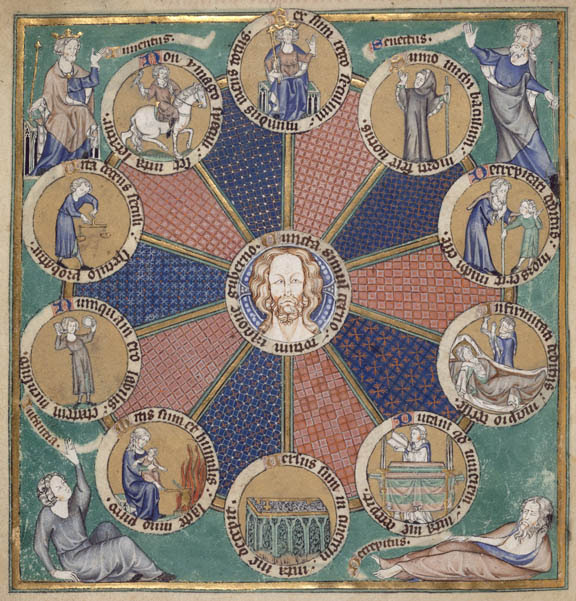
Martha Rust on
Circles, Lines, and Coils:
Picturing Life Stories in Medieval Manuscripts and Rolls.
The set of all points in a plane that are equidistant from a given point, a circle is also an image of totality and completeness. Any two points in the circumference of a circle define a line, making a line the figure of connection and also of boundaries. A version of a circle, a coil suggests cycles as well as wholeness. By way of a separate etymology, “coil” also denotes the busy tumult of life, the “mortal coil” made famous by Shakespeare. All three of these design elements feature in medieval images and diagrams depicting typical life stories and exemplary life practices that were meant to aid a viewer in successfully negotiating that busy tumult. Among these works, images of the Wheel of Fortune are primarily pictorial while Wheel of Sevens diagrams based on the petitions of the Lord’s Prayer are primarily textual. In between are diagrams that feature a smaller circular element, the roundel. A look at the use roundels in a range of contexts–in stained glass, in Books of Hours, in genealogies–demonstrates that unlike the all-encompassing circle, the roundel isolates specific items of information and lends them visual emphasis.The use of roundels in a diagram displaying the ten stages of human life renders each a subject of contemplation, even as the lines connecting all ten roundels to a central hub pictures an individual life as part of a larger cycle. By contrast, the use of roundels of the “Pater Noster Table” in the Vernon Manuscript creates a visual hierarchy of information, in which the content of the roundels not only have priority over the lines of text that connect them but also become subject to a viewer’s mental manipulation.
Martha Rust is an associate professor of English at New York University, specializing in late-medieval English literature and manuscript culture. Her first book, Imaginary Worlds in Medieval Books: Exploring the Manuscript Matrix (Palgrave, 2007) envisioned the confines of a medieval manuscript as the potential territory of a virtual world; her current book project, Item: Lists and the Poetics of Reckoning in Late-Medieval England theorizes the list as a device that enables thinking in a variety of modes. She has also written about comics and picture stories in an essay entitled “It’s a Magical World: The Page in Comics and Medieval Manuscripts.”
The 161st meeting of the NY Comics & Picture-story Symposium will be held on Tuesday, Sept. 27, 2016 at 7pm at Parsons School of Design, The New School, 2 West 13th Street, in the Bark Room (off the lobby).
Free and open to the public.